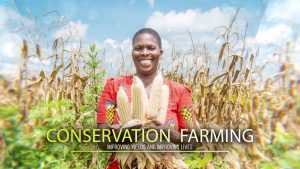
Conservation Farming works. It is not a technology that looks nice on paper but can’t be scaled up by ordinary people faced by ordinary challenges. It works quickly and visibly and it changes lives. There are thousands of people who have testified to this – here are a tiny sample of people we have interviewed recently.
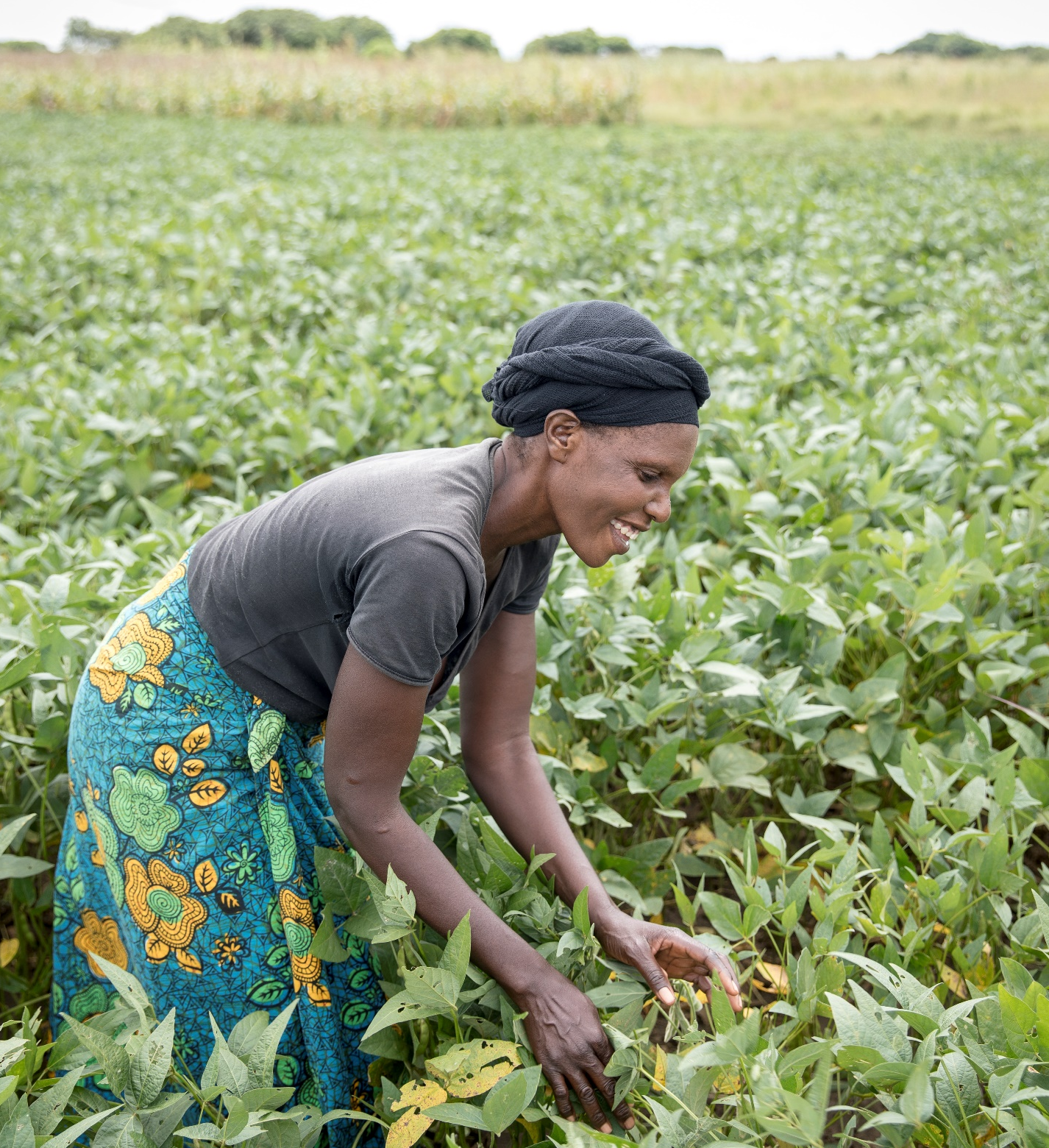
Cecilia Nyrongo lives in Makoka village in Kasavasa area near Kabwe. She has been practising CF for 5 years, after hearing about it on the radio and then making contact with the CFU when they came into her area. She has learnt about CF from her female FC Ruth Nyrongo, and they are both supported by the local CFU Field Officer Ruth Phiri. This strong woman manages without a husband to support her 16 children and grandchildren, who depend on her and the profits from her farming.
Before, when she was farming conventionally, she cultivated 2ha. Now she manages 10 ha, through land she lives on and uses, neighbouring land she rents, and a 4ha farm she has recently managed to buy near Kapiri. She has been able to expand the area because she uses herbicides, which makes weeding time far shorter, even though before she would sometimes hire casual labour to supplement their efforts.
She prepares her land by hiring tractor ripping services (TSP). This year, she finished with her land prep by September. Her previous yields used to be around 35 x 50gs bags of maize in a good year, so from her 2ha, she would get about 70 x 50kgs bags. Now she averages about 100 x 50kg bags per hectare, which means that on the 10ha she farms, she has the potential to earn 1,000 bags. Now her family eat better, she manages to pay the school fees for 5 of the children still of school age, and she is keeping chickens.
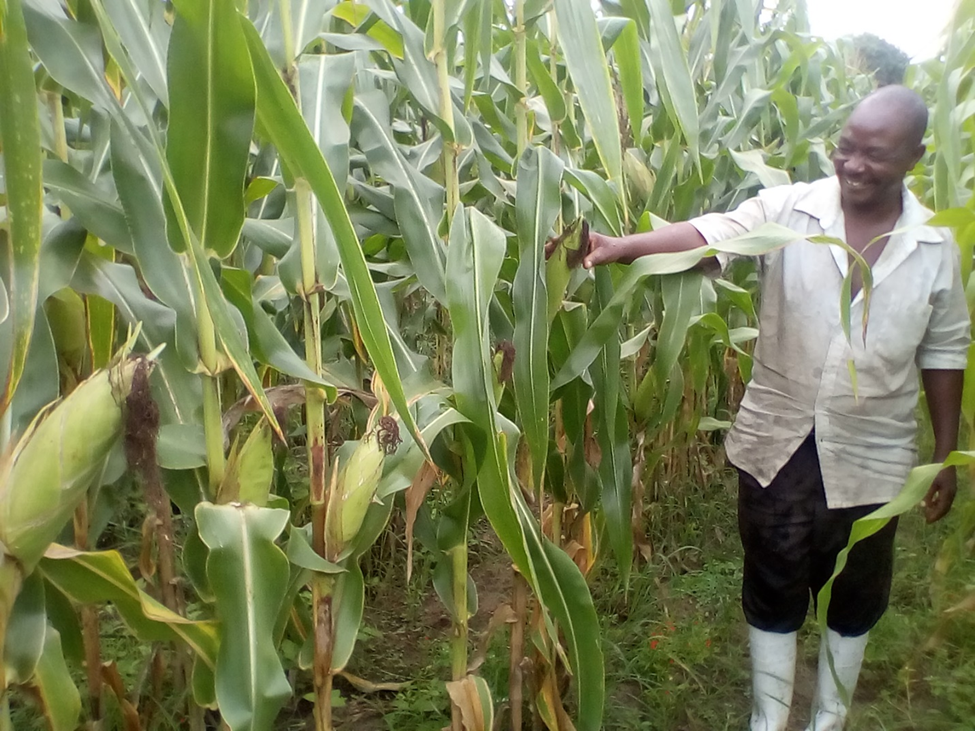
All eyes are on Mr. Banda’s field, which has a good crop in an area that experienced a 37-day dry spell from the 24th of December to the 5th of February. A 50-year-old man, Mr. Smart Banda, a husband and father of eight children, resides in Moffati village, which is about 17km away from Vubwi Central District. Having been a conventional farmer for many years, he decided to try CF last year, after first receiving training through the CFU and becoming a Farmer Coordinator. While he had heard about the use of Hand Hoe Basins from other organisations, he had not received any formal training, and had never heard about it the use of ADP (oxen) ripping till he received formal training from the CFU on both CF Hand Hoe and ADP Minimum Tillage.
Mr. Banda started with a hectare, and did both ripping and hand hoe basins planting 15kg and 10 kg of maize seed in each plot, respectively. Although it was his first time to practice ADP ripping, his oxen are well trained and, as such, didn’t experience much difficulty in making rip lines. His wife and children were told how to plant in the rip lines and basin, and they did a good job.
As he explained how his wife feels about CF, this ‘system of farming is easy and simple because it involves less work, especially during weeding. There is no need to go in with hoes over and over like we used to do in the conventional system, but you just use herbicides, which is fast and easy.’
‘For me, CF is a good farming system because when we planted, the crop emergence was good, and crop stand was equally good, as you can see by the size of the cobs, and I am expecting more than 100bags by 50kg from the 25 kg of maize seed I planted.’
‘Having this good crop is because I prepared myself. I bought the seed and fertilisers in time and did my land preparation early, which made me plant with the first rains in November 2017. I applied all fertilisers in good time. If I were to wait for FSIP, I would have been in the same situation as many others who waited for it, and their crop tussled without any fertiliser at knee height (prematurely).’
He went on to say that ‘my fellow farmers who didn’t believe in the training they received from CFU are now surprised by the way my crop is doing, and many farmers are showing interest in doing conservation farming this coming season because of what they are seeing. I have come to love this farming system, and this coming season I want to expand my CF field to 5 hectares and plant different crops.’
Finally, Mr. Banda feels that ‘all in all, CF does well when you prepare yourself, as a farmer does land preparation early, buy the farming inputs on time and makes sure you manage the weeds on time, then you expect more yields.’
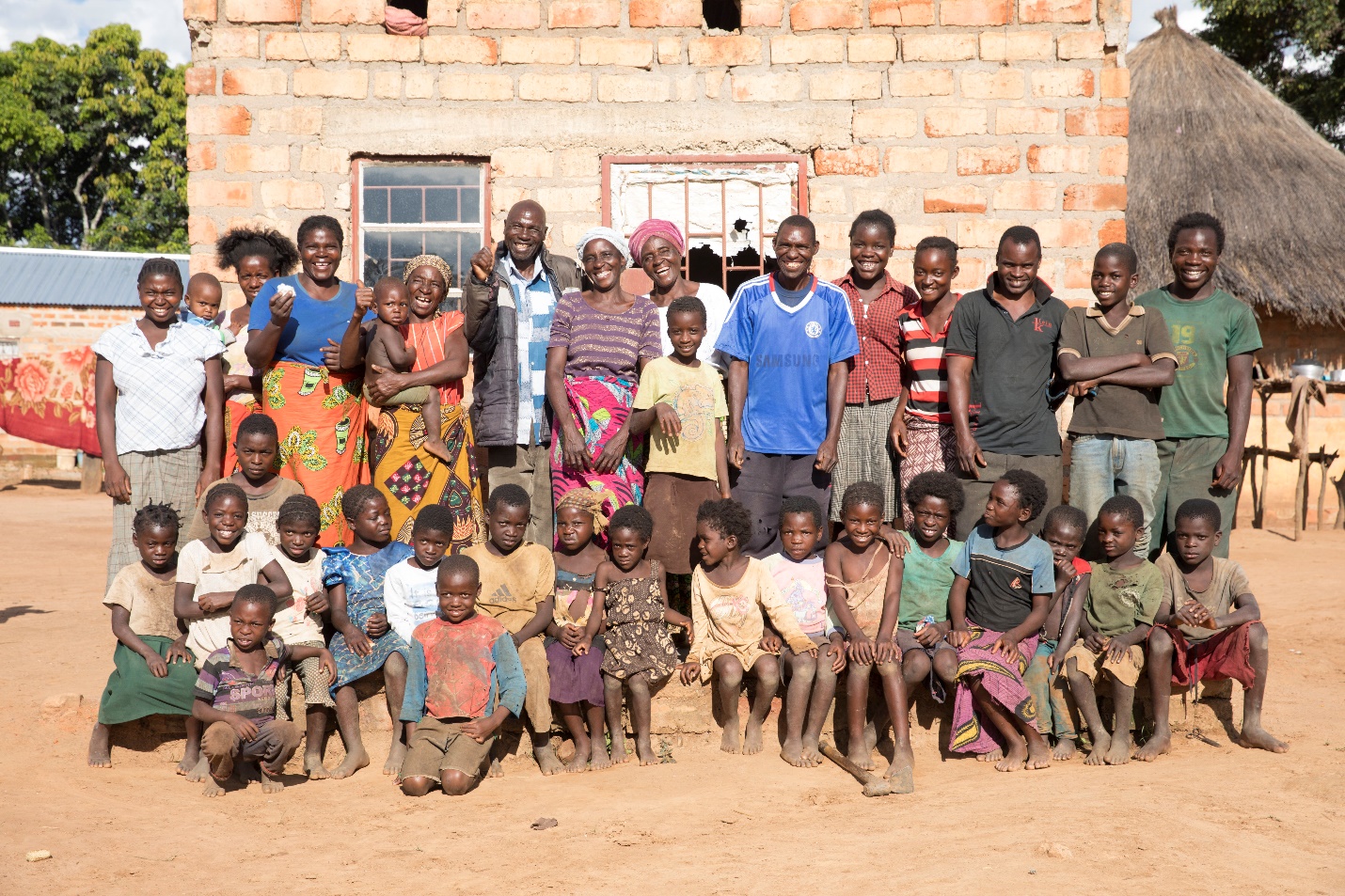
Ethorn Kapoba, of Kapoba village in Nagoma, is a man with a large family. He has three wives, and a total of 30 dependents, mostly children. For many years, they were food insecure and only managed to get by through selling cattle for money.
He has now been practising Conservation Farming since 2015, after attending a training held by his local Farmer Coordinator, Dimas Mukanta, whom he now holds in high regard.
Being careful, he decided to try just one lima to start with that first season, and was amazed when he yielded 60 x 50 kg bags of maize, when his normal yield before was 10 to 15 bags only. He has now fully converted to doing CF, and in 2017 planted 5ha of maize, 2ha of cotton and 4ha of soya using his oxen to rip. Although this is a smaller area than what he previously farmed, as he points out, his yields under conventional farming were poor. Now he farms a reduced area and gets much higher yields. This year, despite the very difficult season, he still expects to yield 2 tons of cotton per hectare and 200 x 50kg bags of maize per hectare. He manages this feat by being able to put large amounts of cattle manure on the fields. However, he says that he used to do this with his conventional crops too, but made the mistake of just scattering and spreading the manure everywhere, rather than carefully placing it in the rip lines alone, as advised by the CFU.
Since starting CF three years ago, he has been able to build a new house, has been paying for 26 children in school (including one at University) and is food secure.
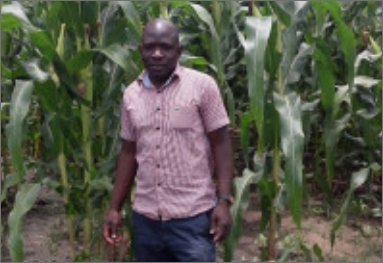
Reuben Shamboze has a background of being one of the successful businessmen in Nangoma’s Corner Bar area. He owns a big shop where he is stocking hardware, building materials and seed. He spent about 12 years just concentrating on this business, but decided to start farming as a business (in 2016/17) because his hardware business is seasonal from April to somewhere around October, after which the sales go down from November to March, and there is not much activity.
During the first season (2016/17), Reuben did about 5 hectares of maize for a start, all of which was based upon conventional tillage. He hired animals to plough his fields, and after ploughing, they went in and made some furrows, planted and buried the seed.
Fortunately enough, the rain season was very good and made him harvest about 260 x 50Kgs bags of maize from the 5Ha. In the following season (2017/2018), he heard about the CFU trainings from other people, and he decided to attend the trainings held by a nearby Farmer Coordinator. Ruben quickly realised the amount of money he had unnecessarily been spending on all those field operations he underwent on conventional tillage systems, which, if he did CA, could be cut off by half.
Straight away, Reuben decided to adopt the technology, and hired a tractor to rip 10 Hectares, and oxen to rip a further 2 hectares with bad stumps, all of which he planted with Maize. He now expects to yield about 130 x 50kgs bags per Hectare, totalling an estimated 1,560 x 50kg bags.
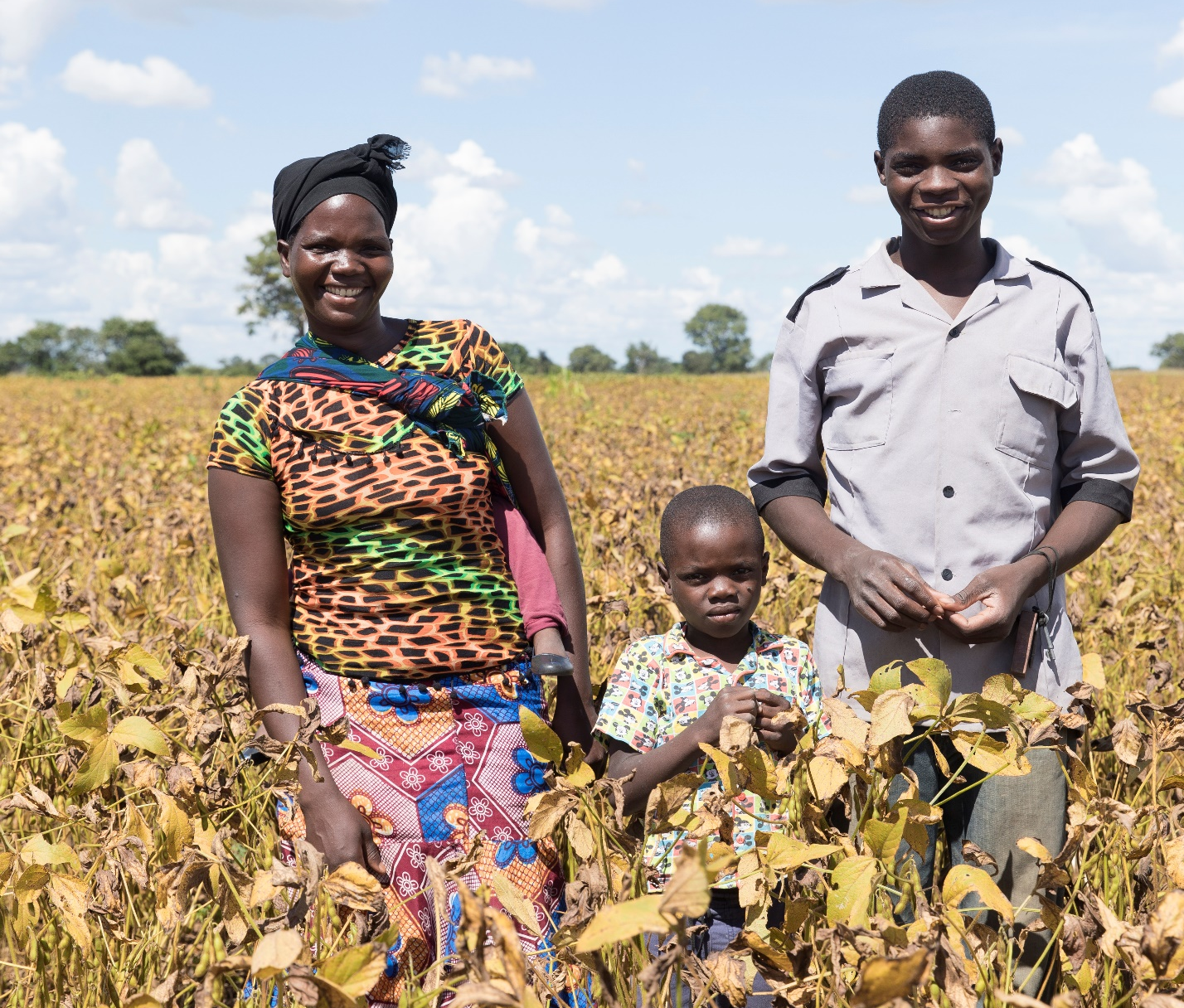
Anne Mumba lives in Mukonchi, near Kabwe, with her seven children. She is divorced. In spite of this, she manages to feed her children and pay for all of their school fees.
The 2017/18 season was her second year doing CF, having been trained by her local FC Wilson Sakala. She planted 3ha of maize and 3 ha of soya, and ripped using her own oxen, starting in the cold season and finishing long before the rains came. She says that since doing CF, her yields have increased very much. Even this year, with the very hard dry spell in January, she expects bigger yields than she got with her best year doing conventional.
Herbicides allow her to manage, making her operations cheaper and faster. Previously, he used to have to pay for piece work, which was more expensive.
Anne told us that before CF, she was farming a smaller amount of land, but had to send more time doing labour. Now she farms a bigger area of land, but spends less time doing it. With the new time she now has, she is doing vegetable gardening and can spend more time with her children.
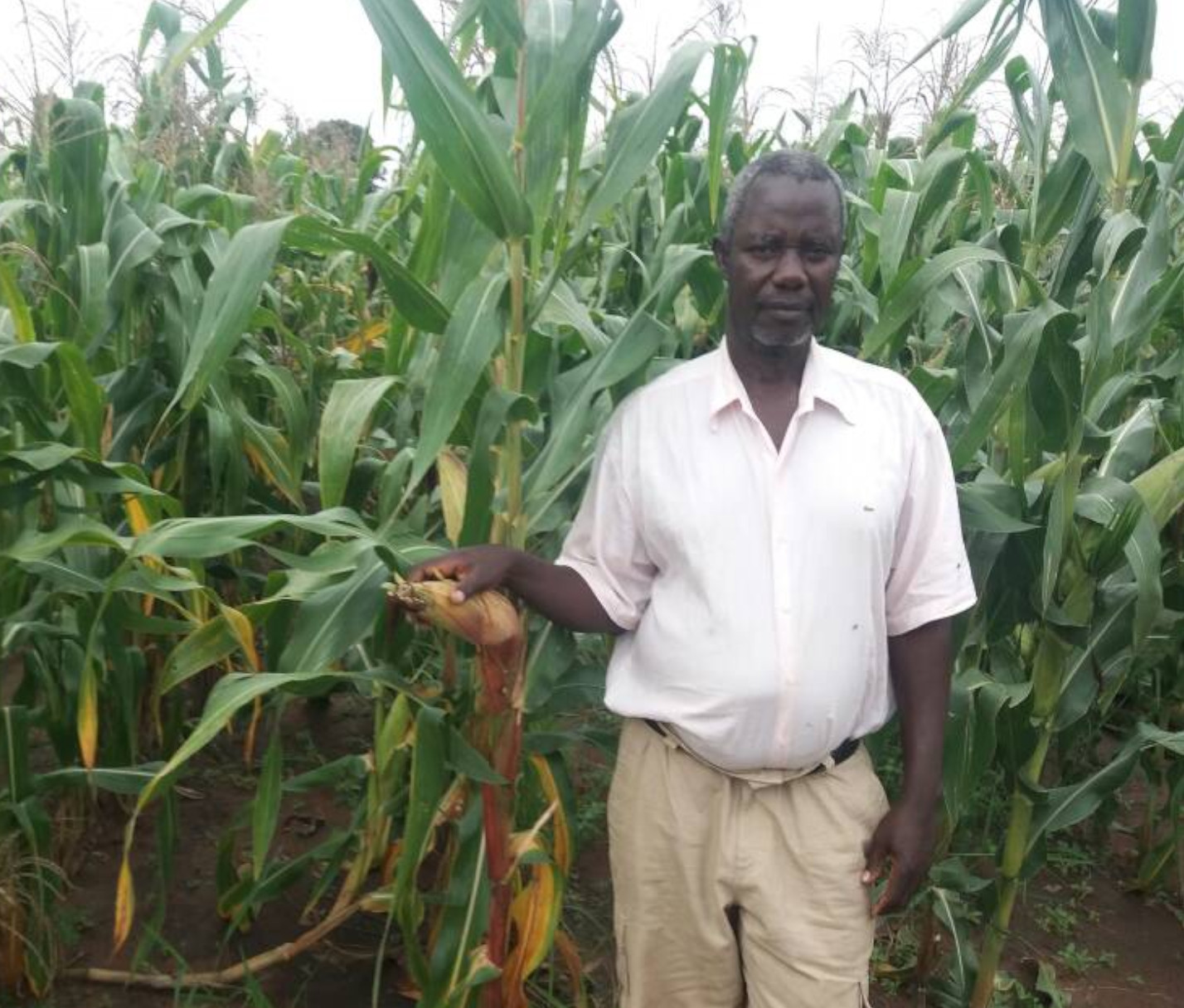
After his retirement in 2004, Mr Vincent Sepiso (from Kabulwebulwe, Mumbwa District) started farming, using conventional farming practices. Despite the hard labour he was getting very low yields, and his field was becoming depleted in terms of nutrients. Since he started farming, the highest yield he had ever achieved, even in a good season, was 15 × 50 kg of maize per hectare.
Mr Sepiso had attended CFU training for many years and thought doing CF was a sheer waste of time, and never bothered to do it until the 2017/2018 season, when his local CFU Farmer Coordinator saw that Mr Sepiso had been attending training and never trying. The FC decided to make him a host farmer for 3 sessions of all three periodical trainings, after which he decided to “try just 10 kg of maize seed on my 2 Limas of hired ADP Rip lines”. The rest of the field was done using his usual conventional tillage practices. To his surprise, the CF plot has done much better than the conventional plots. Sepiso testified to say, “even during the dry spell the CF plot seemed as if someone was watering it while the conventional plot was badly hit by the dry spell which lasted for 6 weeks in this area.” Mr Sepiso is now blaming himself for the late adoption, by this time he would have reached another level.
Mr Sepiso hosted a mini field day on 07/03/2018, and during the Field day, Sepiso told his fellow farmers that CF is the only way to go; it's cheaper, less labour, and the field continues to be productive. Sepiso said he will never in his life do conventional practices again. Sepiso said this year he will do 3-hectare maize, soya beans 2 ha and 1 sunflower on CF.
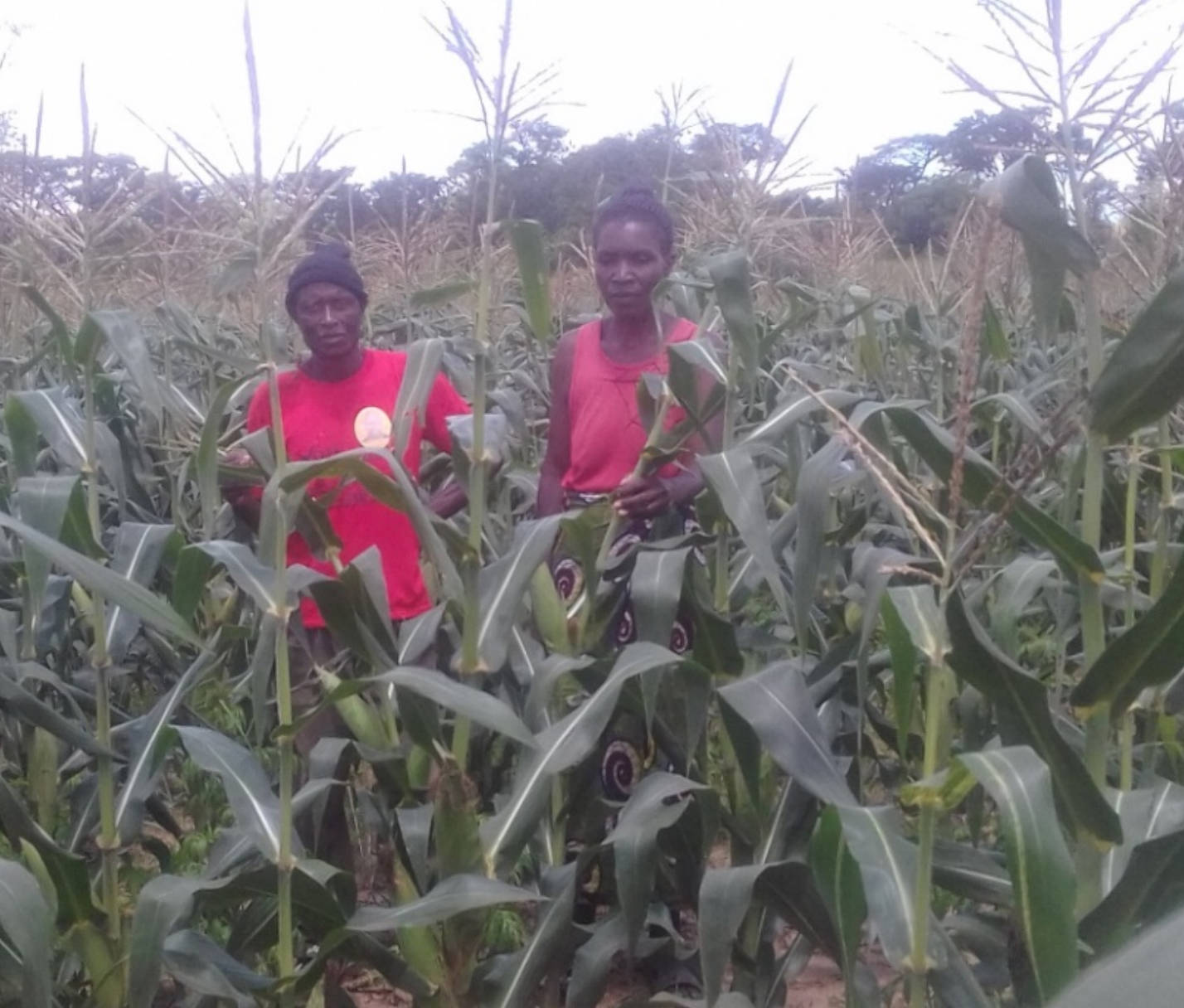
The image above is of Mr and Mrs Siatubi, first season CF adopters from Magalela village in Zimba District, Southern Province.
When questioned about their CF experience, they had this to say: ‘We normally cultivate 6ha of maize under conventional practice, but this time around, after attending the three trainings that CFU offer, we decided to try out 1.5ha of maize under CF.’ ‘So far, the CF crop is doing very well despite the long dry spell experienced in January 2018, and we anticipate that the yield we will get from the CF plot will be double that of the ploughed fields.’
They went on to say that ‘normally, we get 4 ox-carts (56 × 50Kg bags, 2.8t/ha) from a hectare, now in this ripped field, we think we will harvest 4 more ox-carts per hectare (5.6t/ha),’ double their previous yields.
They also said that their CF field looks like ‘a proper field’ with less run-off and gullies caused by erosion as compared to the previous years when the plot was under conventional tillage.
The CF ripped field has a good crop stand compared to the conventional field, as seen in the second image below.
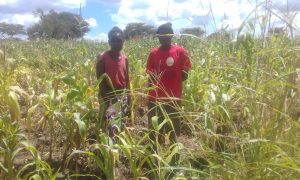
This couple had attended training in previous years, but did not adopt CF/CA. It was only after attending a field day last season that they decided to try CF/CA. Mr and Mrs Siatubi used ADP ripping to prepare the plot with their oxen. They did not use herbicides, but are hoping to include them in their budget next year.
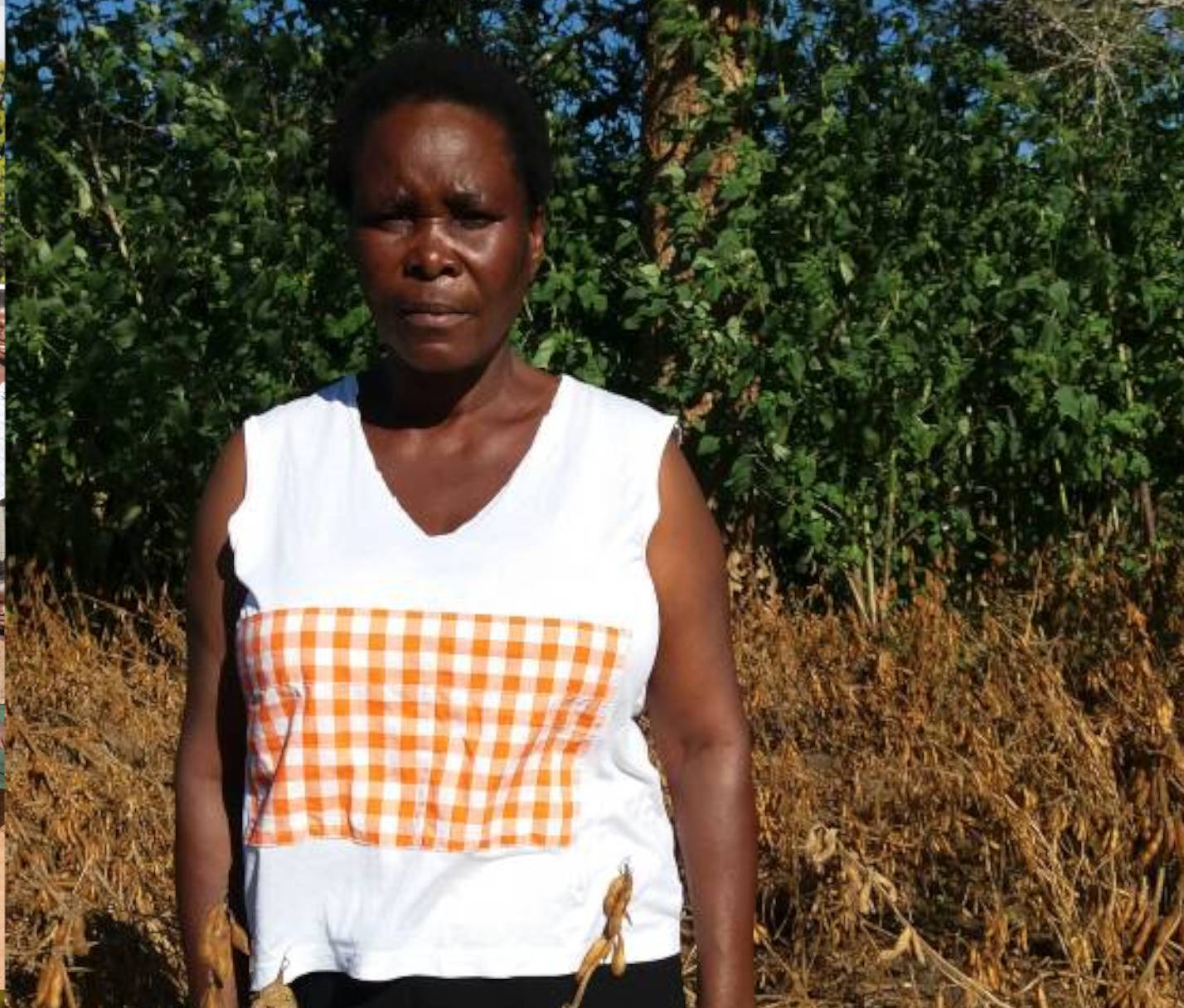
Lucia Munkombo is Farmer Coordinator under the Conservation Farming Unit, residing at the Maimwene Resettlement Scheme, in Mumbwa, Central Province of Zambia.
Ms Munkombo started conservation farming in 2001, eventually becoming a Farmer Coordinator. She is also a widow who lost her husband in 1996 and is currently caring for four grandchildren. These children, and her children before that, have all been put through school from the profits from her farming.
On her thoughts regarding Conservation Farming, she said, "We learn early land preparation and we also teach our farmers how to manage their fields starting at zero”. If the farmers only have access to hoes, they teach farmers how to make basins, spacing and the depth of the holes, and if the farmers have cattle, they teach them ripping. She said when they leave the cattle level, they teach them tractor. Farmers hire the local Tillage Service Provider (TSP) to rip the lines for them if they do not own a tractor.
This year, her area, Mwaimwene, had little rain. Lucia stated that “those who practised Conservation Farming will not have hunger, and will have enough money to educate their children”. When they were teaching the farmers, they taught them that the key to conservation farming is climate change. She added that one needs to see how the rain is falling - if someone is not practising Conservation Farming, they will face hunger because if the rain falls in little amounts, the soil is dry. She felt that in Mumbwa District, there are a lot of farmers who are practising Conservation Farming, and that there is no hunger.
She said those who are dragging their feet are wasting time, because problems in their villages will never end, and that when they call for trainings, they should come and learn the way others do, instead of just sitting and accusing others of bewitching their fields.
Lucia said, “There is no witchcraft... people bewitch themselves because they lag, and those that are lagging should come on board and learn about conservation farming”.

Mr Lancelot Malambo lives in B Concession section of Mumbwa District, in Central Province of Zambia, with his two wives and thirteen (13) children.
Mr Malambo practises conservation farming. This year he mainly grew soya beans, cultivating seventy-two hectares, compared to 12 hectares of maize. During a CFU Field day at his farm, he stated that he is proud of his achievement in the farming season 2017/2018. He ripped all his fields in October 2017, and then waited for the rains to come, and when the rains came, he started planting.
Despite having a drought in the midst of December, his crop still looks fine and promises a good harvest. He said he enjoys Conservation Farming because it’s cheaper to prepare fields than ploughing. He encouraged other farmers to practise CF, and that they should rip deep at twenty-five or thirty centimetres if possible, depending on the soil texture. He said doing this helps the crops not to suffocate during the dry spell.
He said if other farmers see what he has done, then it’s even possible for them to work as he has done. He paid tribute to the Conservation Farming Unit (CFU) for the unwavering support rendered to him.
Mr Malambo in his soya bean field
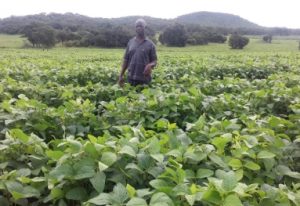
Mr Malambo’s two wives and family
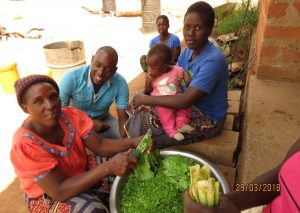
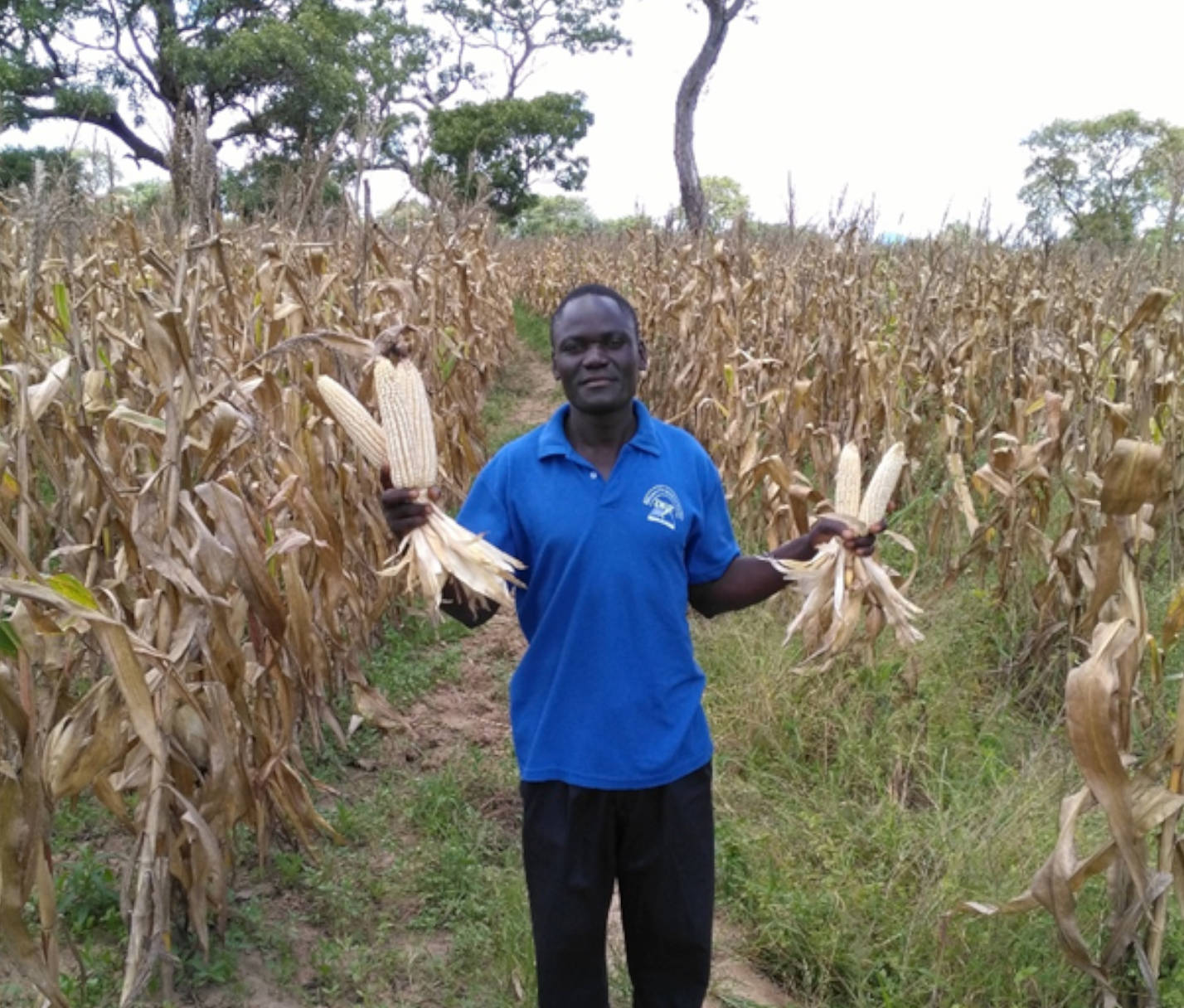
Mr. Zilole Zulu is a 44-year-old farmer from Zilole Farms in Chief Zingalume’s area in Chadiza district. Married with seven children, Mr. Zulu has been farming for a long time using the conventional farming methods of Ox ploughing and ridging.
It was not until 2016 that he heard about conservation farming when he visited a relative in Katete who was a CF ADP MT adopter. He immediately noticed the difference between his crop back in Chadiza and his cousin’s crop, which was far better than his. It dawned on him that this method of farming was worth trying. That same year, he was able to attend the Agri-tech show at GART in Chisamba, where he again saw the CF MT practices being exhibited. The show reinforced his resolve to try out this new farming method.
The attempt to try ADP ripping almost died that first year. Zilole was put off by the price of rippers and had little technical knowledge about how to do CF, having just heard a bit from his cousin, so he did not pursue it further. The following year, in 2017, he came across a CF training in a nearby village, just as it was finishing, so again he felt thwarted. Luckily for Zilole, another CFU Farmer Coordinator, Mr. Yona Banda, visited him to find out why he was not practising CF at his farm, and if there were ways that he (as the Farmer Coordinator) could be of help. Mr. Zulu told Yona that he had been wanting to do ripping but lacked a ripper. Yona offered his ripper to Mr. Zulu to try out. Zilole was so excited that he decided to go at it alone. In the field, the ripper failed to rip as he did not know how to make the necessary adjustments to allow the ripper to reach the desired depth. He ran back to Yona, who came to his aid, showing him and demonstrating how to make needed adjustments for the ripper to attain the correct depth. From that point, Yona worked with Mr. Zulu from manure application, planting through to herbicide application. Luckily, his family was also behind in supporting every effort.
Mr. Zulu decided to try out ADP ripping on a 30-line (rip) experimental plot, to which he planted 10kg of maize. He applied glyphosate to control the first round of weeds before going in with hand hoes to control the follow-up weeds. He also established a section where he planted his crop on conventional ridges established with his oxen. He planted the maize on both sections of the plot on the same day on 25th November 2017 using the same variety of maize. Manure and fertilisers were applied to both plots.
Little did he know that the 2017-2018 season would be one of the worst seasons in recent history for Chadiza, which was hit by a 40-day dry spell lasting from around Christmas to the first week of February. This is when he saw the real difference between ADP ripping and ploughing. His experimental plot of CF ADP MT completely outperformed the rest of the fields. It soon dawned on him that this experimental plot might provide a ‘lifeline’ to his family as the other sections of the field had been so severely affected by the dry spell, with little or no hope of any harvest. From his 30 lines (10kg maize seed) of the CF plot, he is expecting 40 – 50 x 50kgs of maize. After seeing these results, he is planning to increase the portion of his field allocated to CF MT. He also wants to buy his ripper and attend all CF trainings through the Farmer Coordinator.
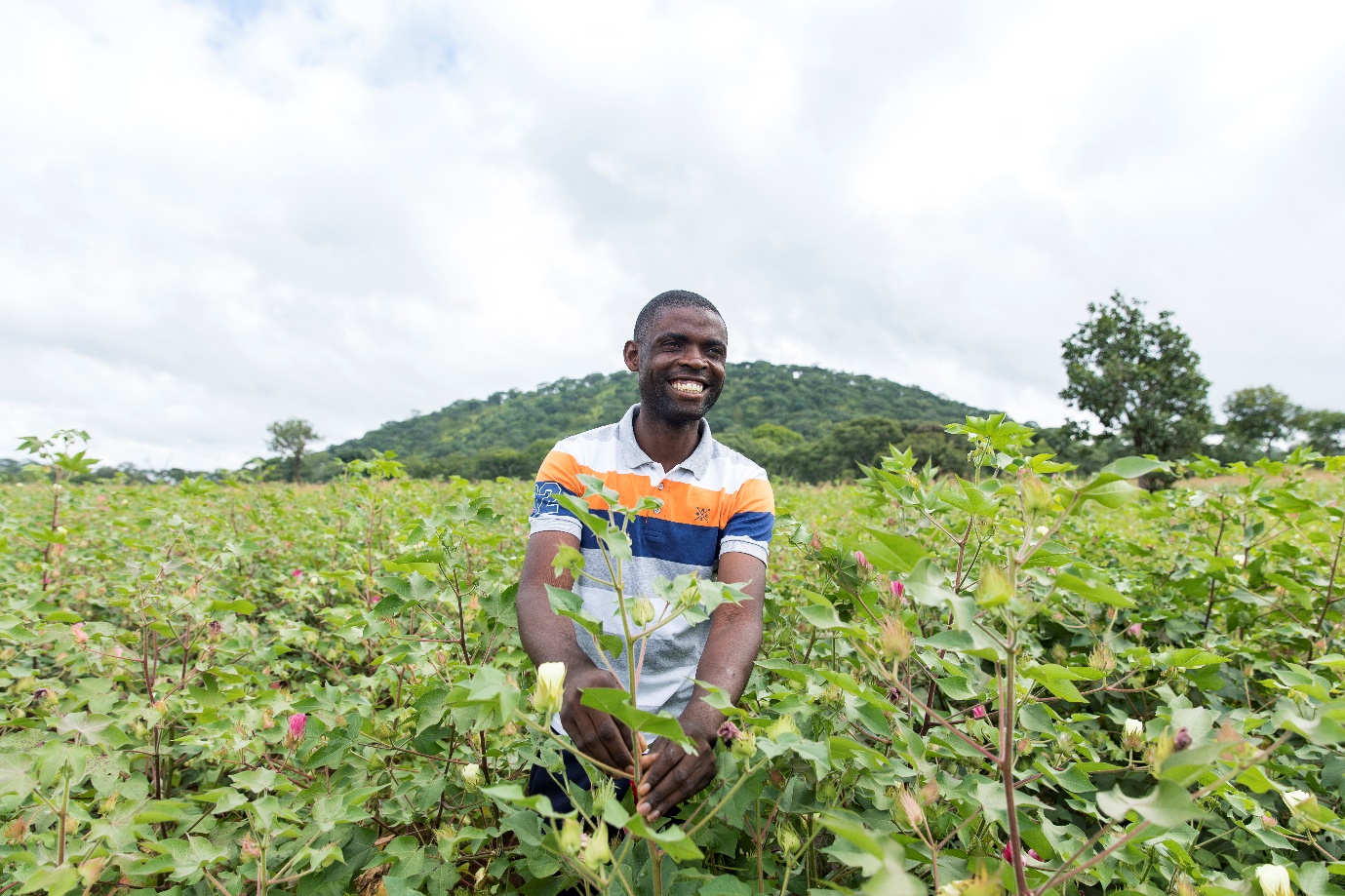
Mr Richmond Songolo is a young man from Mumbwa District who started practising conservation farming in 2015, having received training from his local CFU Farmer Coordinator. He is married with four children - one girl and three boys.
He had previously farmed, for about 4 years, a 2ha field using conventional methods. On average, he would harvest about 160 x 50kgs bags on this field (about 80 bags per Ha). Since switching to Conservation Farming methods, he has been able to expand the area he farms to 13.5 ha, 3.5 ha of which are rented from his neighbour. He has been able to take on this greater area due to the success of the CF methods and the use of herbicides, and the profits that he has realised, part of which he has used to buy a ripper.
Last season he planted 10 ha of maize, 1.5 ha of soya and 2ha of cotton, having used oxen to rip and hired a tractor ripping service. He started this land preparation in June and finished by October. He was all ready and able to plant with the first planting rains on 23rd November. Despite the dry spell that plagued the area, he still expects to yield from his maize field about 250bags per hectare, or 2,500 bags in total. He added that people were surprised to see that the crop was good, thinking that maybe there was rain in his area, when in fact it was the same issue of a dry spell like everywhere else in Mumbwa.
Richmond has just hosted a major field day at his farm, and next year aims to host a District CFU Field Day. He said that, from the time he started Conservation Farming, things have drastically changed for the better for his family. He added that Conservation Farming accords good yields, especially when you follow the instructions accordingly, when cultivating and planting and managing the fields. He said Conservation Farming provides more money in the pockets, despite the fact that you put in less. He said when he used to practise conventional farming, he used to put in a lot of money, but that with conservation farming, it's less money and more income now.
He advised other farmers practising conventional farming that as long as they continued to use that method, they would keep going down and not achieve anything. He said Conservation Farming is a very good system to follow as it’s beneficial, and that there is time for them to change and do the right thing.

Steward Siapalala, is a CF farmer in Itezhi-Tezhi district under Shimukuwaila village of Chief Kaingu. Steward was a conventional farmer since childhood, and his yields ranged between 40 to 45 bags x 50Kgs in a good year and 15 to 23 bags x 50Kg in a bad year.
When conservation farming was introduced to him in 2012 by the Ministry of Agriculture, he never liked it - he thought it was for poor people. He thought of trying it using the Magoye ripper, which he bought at Magoye research station, but the results were very poor because he had no knowledge about the technology, and by then, the use of herbicides was not pronounced in the area. Disliking the technology, he abandoned his Magoye ripper for some years, taking it to be a waste of time to rip because he thought it came with too many challenges, including weeds..
When conservation farming was reintroduced to him by the CFU in conjunction with the UNDP, he thought of trying it again because the training he received was slightly different from those he had received before. He attended all three Periodical training in 2017, ranging from Land Preparation, Basal nutrient application and seeding of all crops, weeds and integrated pest management. He used oxen (ADP) ripping and planted 1 Ha of maize and 1.5 Ha of soya beans.
Despite being a very difficult season all in extremes of dry spells, army worms and excessive rains, Stewart has reason to rejoice because the crop estimate as at now stands at 100 to 170 x 50Kgs bags of maize per hectare, while Soyabeans are at 80 to 100 bags x 50Kgs. This is his first time he is planting soybeans after receiving the training on the benefits of crop rotation. He also did 1ha of maize under conventional tillage using ADP ploughing. To his surprise, there was a very distinct difference in spite of the inputs being applied equally. The evidence is clear in these pictures:
The yields from his conventional maize field are being estimated at 28 x 50Kgs bags per hectare. Stewart vows never to go back to the conventional way of farming but to continue with CF, for it has saved his time, labour, money and also health. He has realised it’s a cheaper yet more profitable way of doing farming. During the dry spell which hit the area for six (6) weeks, his maize in ADP ripping never wilted while that one in an ADP ploughing used to wilt a lot and the chances of recovering were very slim. Stewart Siapalala is hosting one of the area’s major field days by the end of the month for the first time in his life.
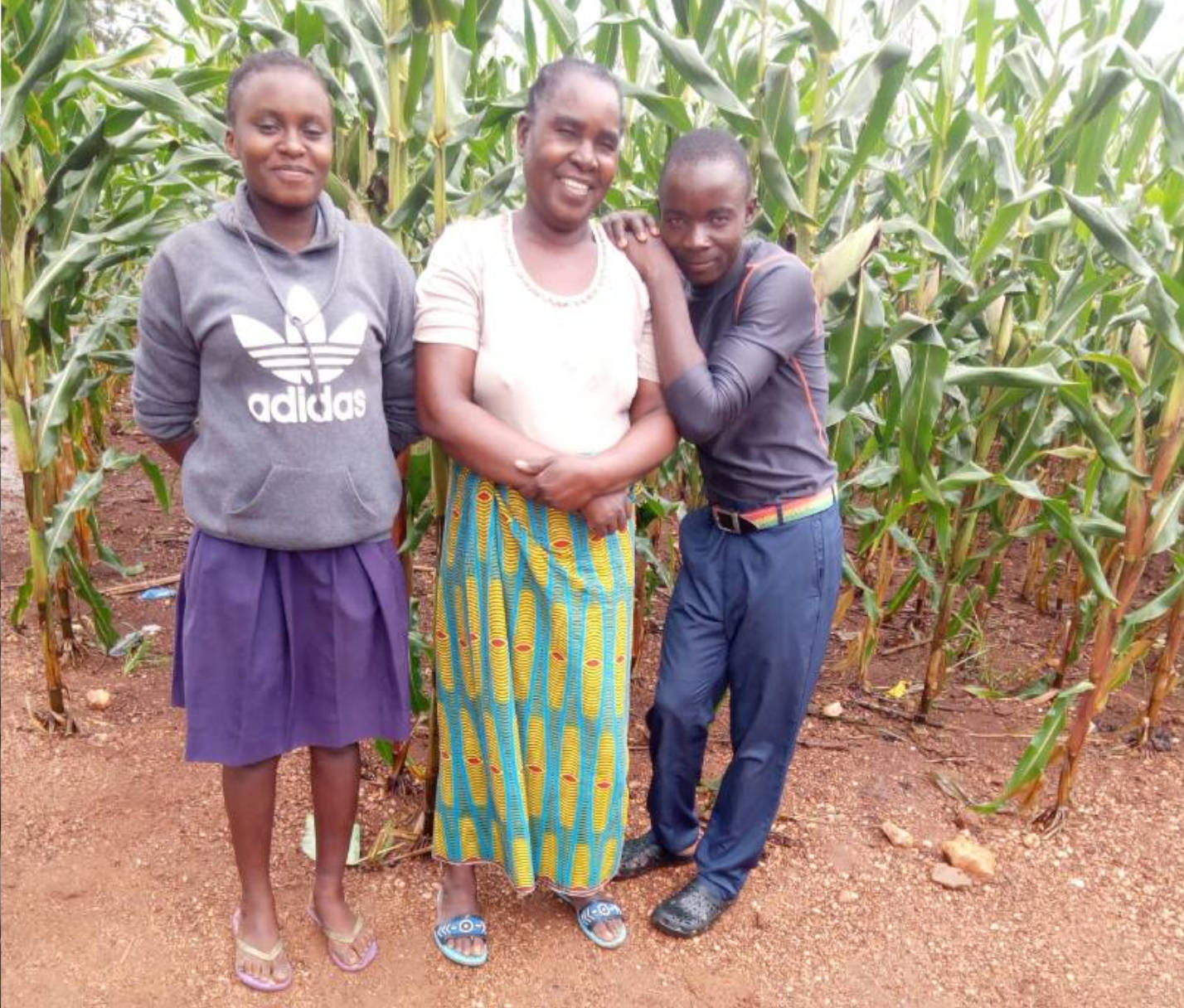
Timale Banda is a farmer who was widowed when her husband died in 2007. He left her with 5 school-going children. In the picture below is Mrs Timale Banda and 2 of her grandchildren. She managed to sponsor the other five of her children to go to school and university, and today, they are grown up and have their own families to look after. She is a hard-working woman who manages to put food on the table for herself and her dependents.
She became an adopter in 2010 after going through the CFU training with her FC. When she started, she did not believe in the system, not until she tried it on a small portion, and her doubting mind was relieved. Later in 2011, the following year, she applied the CF method on all of her land as she prepared for planting. She uses the hand hoe basin method.
She hires labour to prepare her fields and uses maize to pay the workers. Most of this labour consists of people surrounding her farm who do not believe in Conservation Farming. Before she started practising Conservation Farming, her yields were as low as 30 bags per hectare (1.5 tonnes/ha), but today her yields have gone as high as 95 bags per hectare (4.75 tonnes/ha). From all this, she has managed to build a store room where she is keeping her produce and also the inputs that she buys for the coming season. She always keeps part of her produce to pay the labourers who prepare her fields for the next coming season. She is planning to plant a bigger field next season so that when she realises the money from the harvest, she can use part of it to pay for her grandchildren’s school fees.
She starts preparing her fields as early as August. By this time, most of the people are looking for food; therefore, she uses this chance to get more labourers, paying those who want to work in tins of maize to dig lines of basins. Timale doesn’t depend on FISIP; she buys the fertiliser in advance based on her upcoming requirements.
Timale says she will never go back to conventional practices because she knows that at the end of the day, her yields will be so much higher than before she adopted CF practice. She knows that conventional farming has so many disadvantages and tries to convince most of her neighbours to change from conventional to conservation farming. Last but not least, she says, ‘to acquire knowledge is better than just sitting like an empty tin.
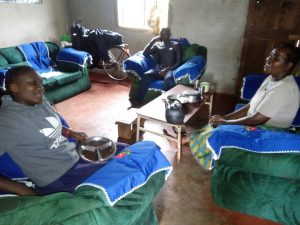
The picture is the inside of her house. These chairs are part of her achievements, bought with cash from CF. She also bought a Top Star [a decoder to use to capture a satellite digital TV signal]. She has managed to purchase a solar system to provide electricity in the house, powering the TV and the entire house.

What follows is the story of CF farmer Mr. Arnold Banda based in Nalufwi in Chisamba Central Region. He owns a 50-hectare farm located 11 kilometres off the Great North Road.
Mr. Banda drew his inspiration for farming from his past employment as an equipment operator at Sunrise Farm in Makeni, Lusaka. Whilst still in employment, he started his farm on rented land in Makeni, he was averaging 40 x 50kg bags of maize on a 2-hectare plot (1tonne/ha) using an ox-drawn plough to till the land. He recalls how his friends tried to discourage him when he told them he intended to give up his job and venture into full-time farming because of the lack of profitability, high risks and uncertainties associated with agriculture.
Mr. Banda left his job at Sunrise after being offered a more lucrative post, but unfortunately, the offer was withdrawn. This finally prompted Mr. Banda to take up farming on his land as a full-time business. From the benefits he accrued from Sunrise Farm, he managed to purchase 50ha of traditional land in Nalufwi, where he built a small house and moved in with the family.
In the farming season of 2014/2015, he ploughed 4 ha of land for maize; this 4 ha yielded only 100 bags x 50kg (1.25 tons/ha); this low yield was repeated in the 2015/2016 season. He blamed the poor soil on his farm and was on the verge of selling half of it out of frustration with what he perceived to be soil infertility.
In 2016, he attended the Conservation Farming Unit training after being invited by the area Field Officer. It was at this point that he and his family’s lives turned a corner and became a success story.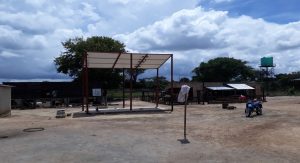
He planted 4 hectares of maize and 4 hectares of soya beans under the method which he had been trained in by the CFU, and it was an instant success for the proud Mr. Banda. He harvested 520 x 50kg bags of maize (6t/ha) and 200 bags (2.5t/ha) of soya beans.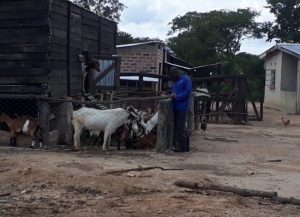
From the sale of some of the 2016/2017 harvest, Mr. Banda managed to finish building the big house which he had started, and invested some money in tomatoes and fresh maize production. Currently, he says his plans are on course as he has managed to purchase 3 solar panels (300 watts each), 6 x 150 watts for irrigation and home utility and smaller ones for lighting on the yard - see photo above. He has also managed to sink a borehole for home use and irrigation purposes and has purchased a 10,000L and a 5,000L water tank as reservoirs.
The 54-year-old Mr. Banda says conservation farming (CF) has made him regret the many years he spent in employment, which did not develop him as planned. Through CF, Mr. Banda says he can pay for his children’s school fees, he has managed to invest in village chickens, under a semi-intensive regime, her also keeps goats and has developed a vegetable garden.
Mr. Banda says his immediate plan for this coming season is to purchase a tractor under a loan scheme and become a minimum tillage TSP, as he has vast knowledge in equipment operation. Other long-term plans are to utilise 20 hectares for livestock, 15hectares for rain-fed crop production and 15 hectares for irrigation.